
United States Economic Forecast 2nd Quarter 2019
19 minute read
19 June 2019
The US economy may continue growing steadily. But with risks—in particular, tariffs on Chinese imports, Fed moves, and potential budget and debt-ceiling standoffs—looming larger, a slowdown looks increasingly likely.
Introduction: What happens when Goldilocks wakes up?
A 19th-century children’s story turned into metaphor for a well-functioning economy in the 1990s. The idea that the economy was neither too hot nor too cold, like the ideal bowl of porridge, is a nice description of an economy that registered a 3.2 percent growth rate in the first quarter but in which inflation remained well under control. But that’s not the end of the fairy tale, of course. Goldilocks eats the porridge and sleeps on the bed—but wakes up to three bears staring at her. In most versions of the story, she jumps out the window and runs away. Understandable, since few of us would want to have to explain such embarrassing circumstances to a trio of bears.
Learn more
Explore our Economics collection
Subscribe to receive the related content from Deloitte Insights
The US economy is likely to wake up soon to some uncomfortable facts. The bears in this case are risks that some observers—especially in financial markets—seem to be willing to sleep through. But there are (at least) three of them. We don’t necessarily want to suggest which of the risks is the papa, the mama, or the baby bear, but the key is this: They are all still very much present and looming larger. And at least one has grown in the past few months.
What bears might Goldilocks face when she wakes up? Well …
Tariffs are taxes, and the new tariffs imposed on Chinese goods are likely to have the usual impact of taxes—and slow US economic growth. Not so long ago, the risk of higher tariffs seemed to be receding. However, trade negotiations with China have run into trouble, and the administration decided to pressure the Chinese in the form of a significant rise in tariffs on US imports from China.1 Estimates of the direct impact on the United States are modest but sufficient to be felt in slower economic growth.2
While the threat of more Fed tightening has dissipated, low interest rates have created some exotic corporate debt instruments. One thing we learned in the last financial crisis is that “exotic instruments” and financial markets are not ideas that coexist together peacefully. The Fed is concerned enough to have mentioned the problem in its latest financial stability report.3
Current budget policy creates a spending cliff in FY 2020 (starting in October 2019) as the temporary lifting of spending caps goes away. Congress could agree to continue the additional spending, or to allow a more gradual decrease. The months-long struggle to pass a disaster relief bill suggests that arriving at such a straightforward outcome will not be easy. The Deloitte baseline assumes that the spending caps revert, creating a significant drag on economic growth in 2020.
The US economy could certainly wake up to a menacing bear or three. But right now there are plenty of signs that the economy is doing well. Job growth at 200,000 per month and moderate inflation suggest that the economy is fundamentally in good shape.4 With any luck, the economy will avoid having to jump out a window to escape.

Scenarios
Our scenarios are designed to demonstrate the different paths down which the Trump administration’s policies and congressional action might take the American economy. Foreign risks have not dissipated, and we’ve incorporated them into the scenarios. But for now, we view the greatest uncertainty in the US economy to be that generated within the nation’s borders.
The baseline (55 percent probability): Consumer spending continues to grow. Fiscal stimulus from the tax bill and the budget agreement pushes growth up in 2019 but is somewhat offset by the impact of US tariffs and foreign response. However, the US government comes to an arrangement with trading partners, and the tariffs are removed quickly. A small increase in trade restrictions adds to business costs in the medium term, but this is offset by lower regulatory costs. A pickup in foreign growth helps to tamp down the dollar and increase demand for US exports, adding to demand. Budget debates continue to add to uncertainty as Congress slowly decides to lift the debt ceiling and pass appropriations for FY 2020, but no further shutdowns occur. As the impact of stimulus fades and the economy feels the effect of higher interest rates, growth slows below potential in 2020.
Recession (25 percent): The economy weakens in late 2019 and early 2020 from the impact of tariffs and the withdrawal of stimulus as the additional spending from this year’s budget agreement goes away. With the economy already weak, a relatively small financial crisis pushes the economy into recession. The Fed and the European Central Bank act to ease conditions, and the financial system recovers relatively rapidly. GDP falls in the second half of 2019 and the first quarter of 2020, and then recovers.
Slower growth (10 percent): Business tax cuts induce little investment spending. Productivity growth becomes even more sluggish. Tariffs remain in place as the United States and its trading partners fail to agree on new global trade arrangements. The tariffs raise costs and disrupt supply chains. Businesses hold back on investments to restructure their supply chains because of uncertainty about future policy. The higher spending authorization from the budget bill translates only slowly into additional federal outlays, reducing the budget bill’s impact on the economy. GDP growth falls to less than 1.5 percent over the forecast period, while the unemployment rate rises.
Productivity bonanza (10 percent): Technological advances begin to lower corporate costs, as deregulation improves business confidence. Improved infrastructure boosts short-run demand and, in the long run, capacity and the productivity of private capital. Tariffs are short-lived and turn out to have a smaller impact than many economists expected. The economy grows 2.5 percent in 2019, with growth at 2.3 percent after 2021, while inflation remains subdued.
Sectors
Consumer spending
The household sector has provided an underpinning of steady growth for the US economy over the past few years. Consumer spending grew steadily even as business investment was weak, exports faced substantial headwinds, and housing stalled. But that’s unsurprising, since job growth has remained quite strong. Even with relatively low wage growth, those jobs have helped put money in consumers’ pockets, enabling households to continue to increase their spending. The continued steady (if modest) growth in house prices has helped, too, since houses are most households’ main form of wealth.
For all the daily speculation about how political developments might affect consumer choices when it comes to spending decisions, political noise seems to be just that—in the background—to consumers who seem focused on their own situations. As long as job growth holds up and house prices keep rising, consumer spending will likely remain strong. And the tax cut, while modest for most consumers, seems to have bolstered their confidence that they can safely spend. More importantly, the tax bill’s fiscal stimulus has continued to tighten the job market. At some point, wages might begin to rise—and that could give consumer spending a further boost.
The medium term presents a different picture. Many American consumers spent the 1990s and ’00s trying to maintain spending even as incomes stagnated. But now they are wiser (and older, which is another challenge, as many baby boomers face imminent retirement with inadequate savings5). That may constrain spending and require higher savings in the future. And although American households seem to face fewer obstacles in their pursuit of the good life than just a few years ago, rising income inequality could pose a significant challenge for the sector’s long-run health. For instance, low unemployment hasn’t alleviated many people’s economic insecurity: Four in 10 adults would be able to cover an unexpected US$400 expense only by borrowing money or selling something.6 For more about inequality, see Income inequality in the United States: What do we know and what does it mean?,7 Deloitte’s most recent examination of the issue.
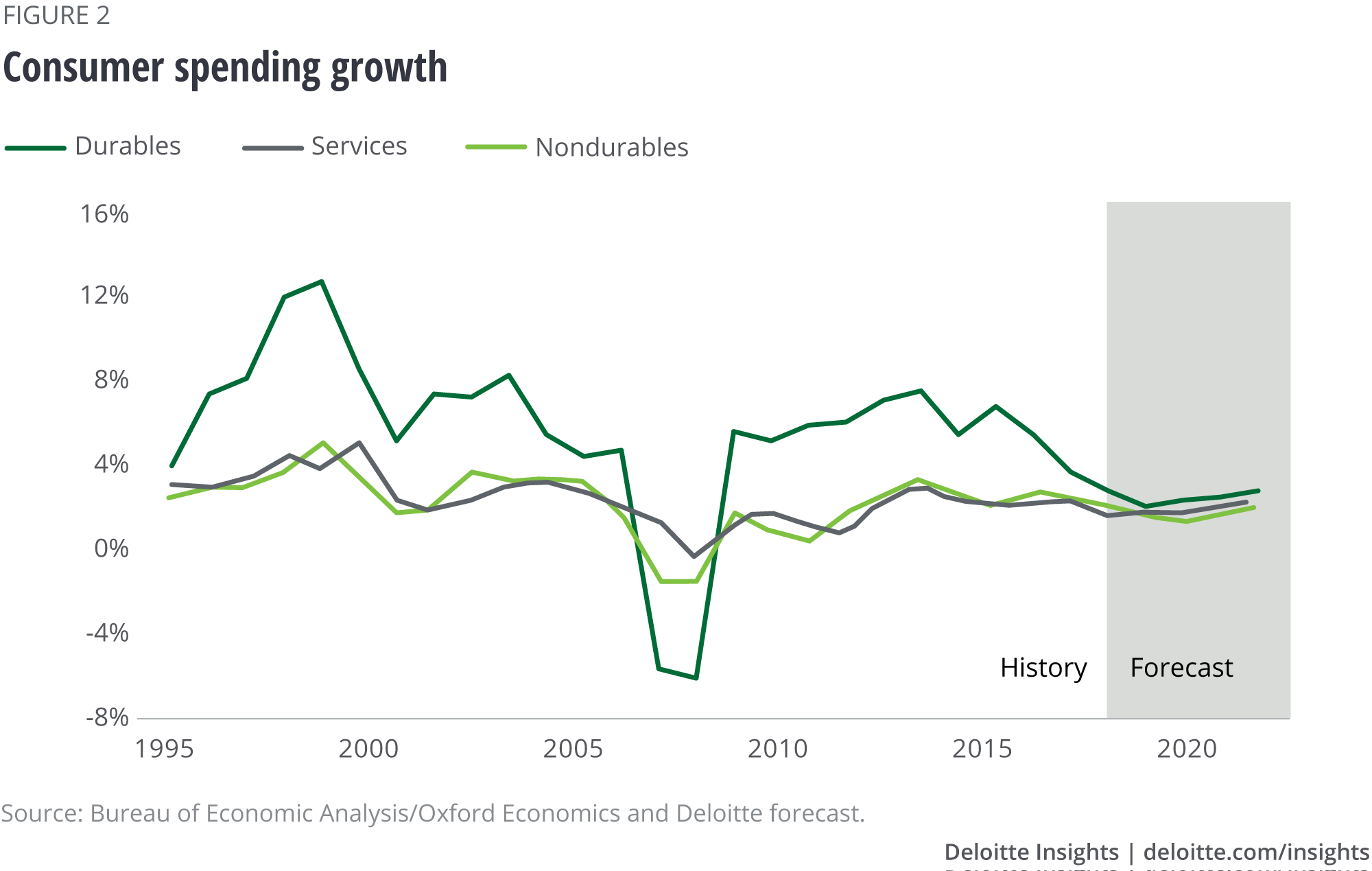
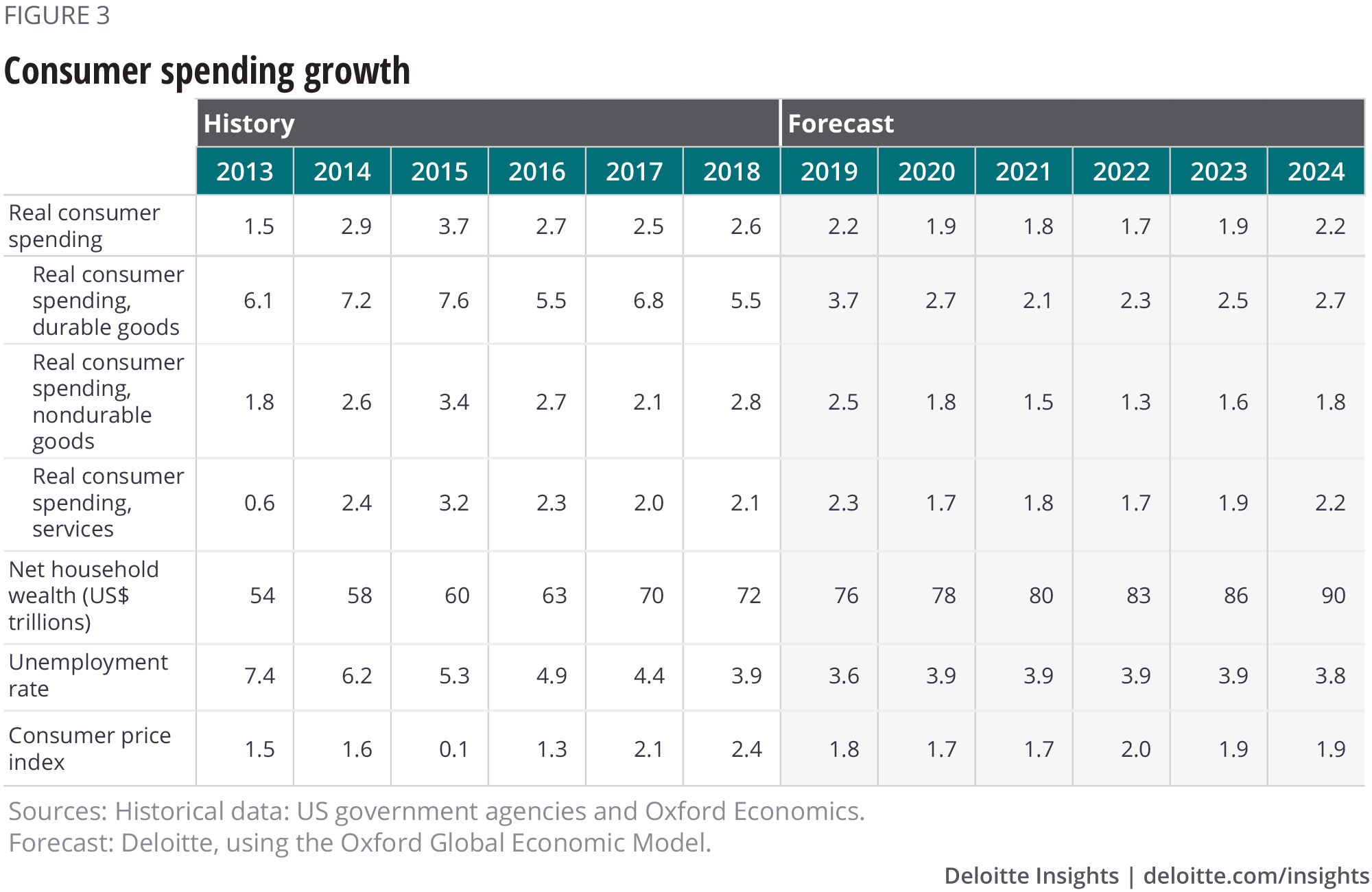
Housing
The housing market has weakened. In fact, we might have seen the best of the recovery from the sector’s destruction in the 2007–09 crash. Housing starts at the current level of around 1.2 to 1.3 million may be the best we can get. A simple model of the market based on demographics and reasonable assumptions about the depreciation of the housing stock suggests that housing starts are likely to stay in the 1.1–1.2 million range. Starts are likely to fall as the economy weakens in the next year or two, and then gradually increase over the five-year horizon. Even the most optimistic view, however, does not allow for housing starts to return to anything like the 2 million-plus level registered in the mid-2000s. Housing remains a smaller share of the economy than it was before the Great Recession, and that’s to be expected. In some ways, it’s a relief to see the sector return to “normalcy.” But with slowing population growth, housing simply can’t be a major generator of growth for the US economy in the medium and long run.
Some folks are reacting to the slowing housing market with alarm, remembering something about how the last recession was connected to a housing problem.8 It’s certainly not a happy sight, especially for anybody in the home construction business. But a construction decline didn’t cause the last recession: Construction began subtracting from GDP growth in the fourth quarter of 2005, two years before the recession, and GDP growth remained healthy. It was housing finance that ultimately created the crisis, not housing itself. Today, housing accounts for just under 4.0 percent of GDP, down from about 6.0 percent in 2005. The sector simply isn’t large enough to cause a recession—unless, once again, huge hidden bets on housing prices come to light.
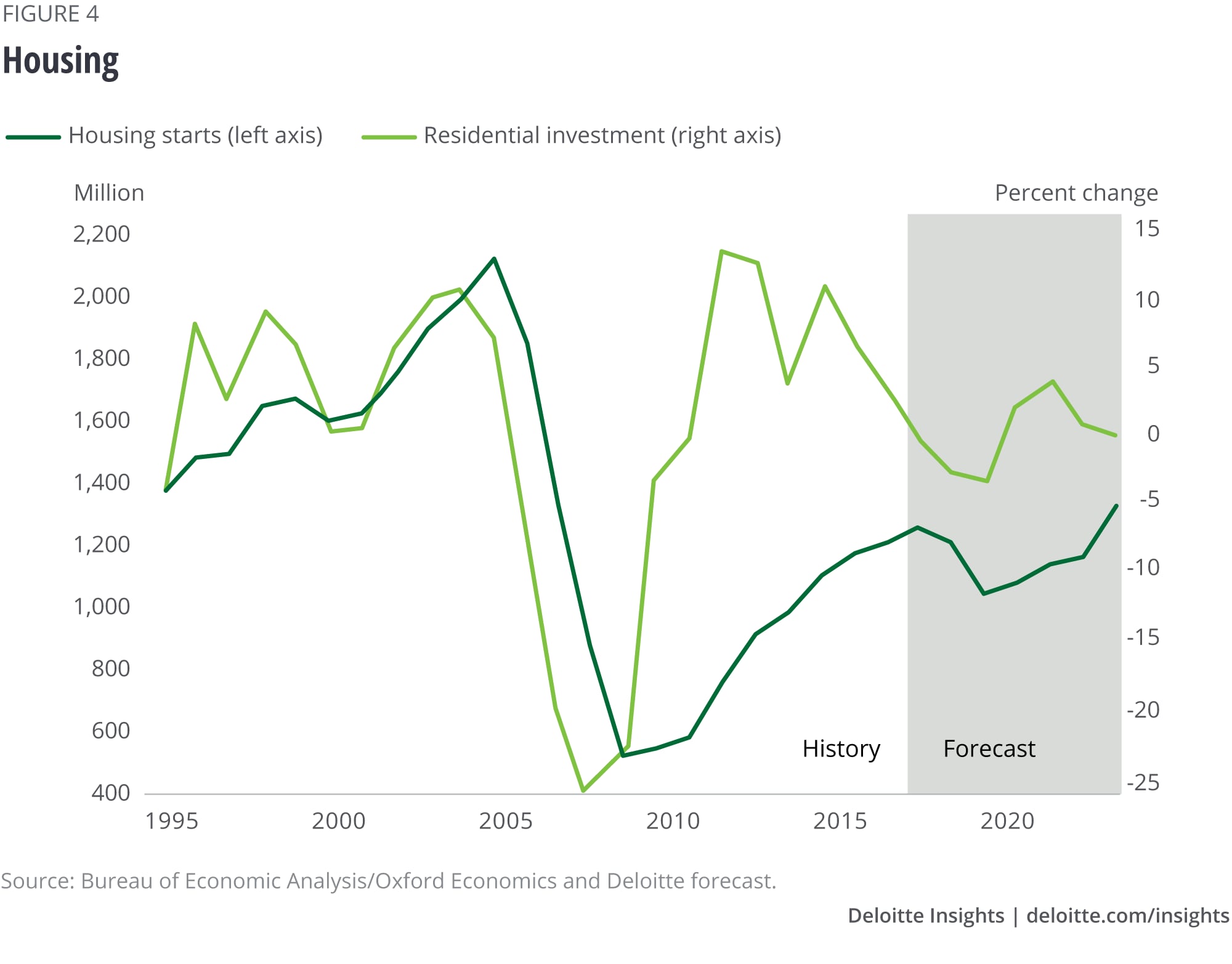
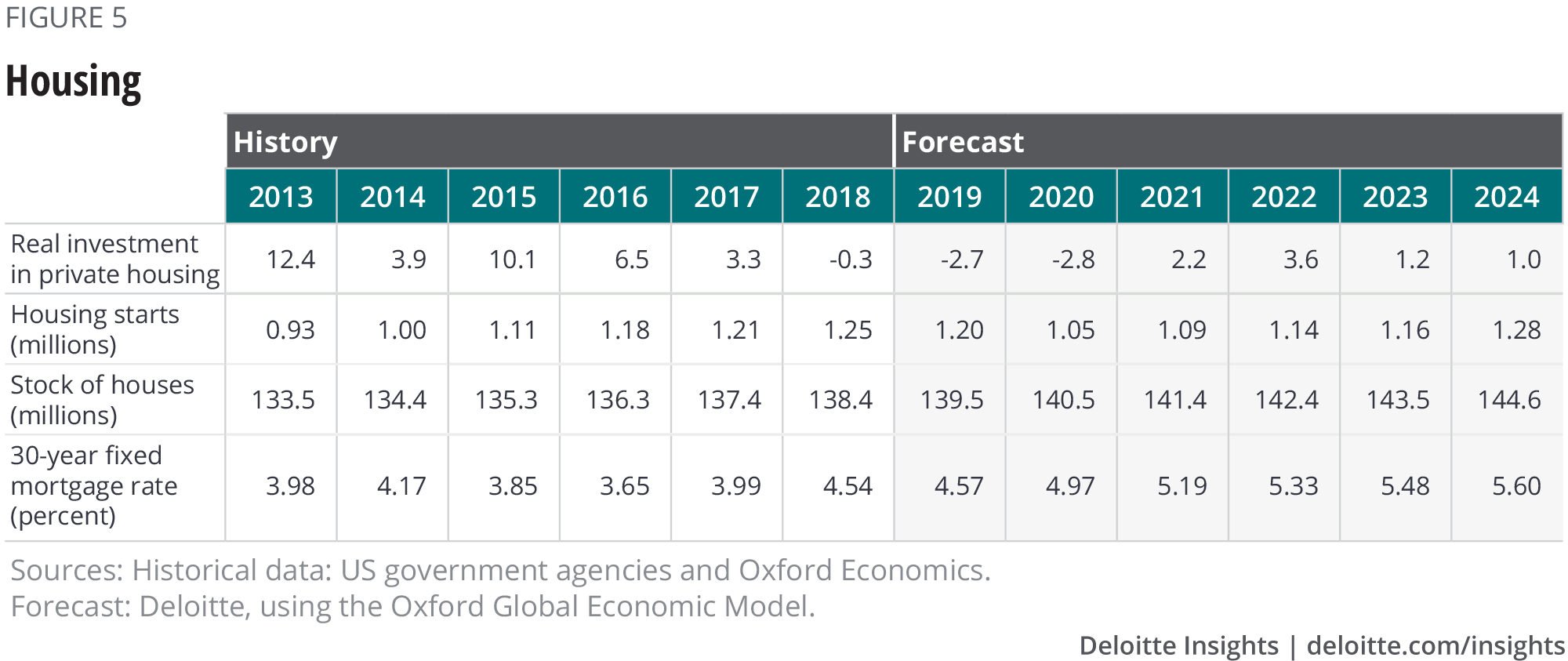
Business investment
While businesses were still reckoning with the implications of the tax bill for investment, the US government introduced additional uncertainty in a radical shift in international trade policy.9 Nor has budget uncertainty disappeared with the enactment of full appropriations for FY 2019. Policy uncer tainty is one of the biggest potential roadblocks to strong investment spending.
Business investment soared in the first two quarters of 2018. However, it takes time for business decisions to result in new investment being put in place, suggesting that this investment spike was unlikely to have been a result of the tax bill passed at the very end of 2017. Since then, business spending has grown at very slow rates (although intellectual property investment has been growing quickly). In truth, the cost of capital has been at historic lows over the past decade, but many businesses have remained reluctant to take advantage of cheap capital to raise investment. So cutting the cost of capital further by slashing the tax rate may have at best a modest impact. While our forecast is optimistic about the potential impact of the tax reform bill, that amounts to likely adding only 0.1 to 0.2 percentage points to GDP growth in the next few years.
The imposition of tariffs on a wide variety of goods—and foreign retaliation in the form of tariffs on American products—creates a large degree of uncertainty, particularly for manufacturing firms. Some CEOs may face a painful medium-term dilemma: deciding whether their businesses need to rebuild their supply chains. Industries such as automobile production have developed intricate networks across North America and are reaching into Asia and Europe, based on the longstanding assumption that materials and parts can be moved across borders with little cost or disruption.
And fiscal policy uncertainty didn’t disappear with the passing of the final appropriations bills for FY 2019. It seems as though each step taken in the direction of reducing fiscal uncertainty leads to yet another deadline. The next two are the need to raise the debt ceiling—in the late summer—and the need to pass the appropriations bills for FY 2020 by the end of September. Much of the negotiation about appropriations has been quiet, but Congress has had a great deal of trouble passing a normally uncontroversial disaster relief funding bill.10 Policy uncertainty is therefore likely to continue to weigh on investment decisions.
The Deloitte economics team remains optimistic about investment in the medium term, since the US economy remains a fundamentally good place to do business. But business investment plays a key role in differentiating between Deloitte’s baseline, slow-growth, and productivity-bonanza scenarios. If policy uncertainty does indeed weaken business spending further, the likelihood of the slow-growth scenario would substantially increase.

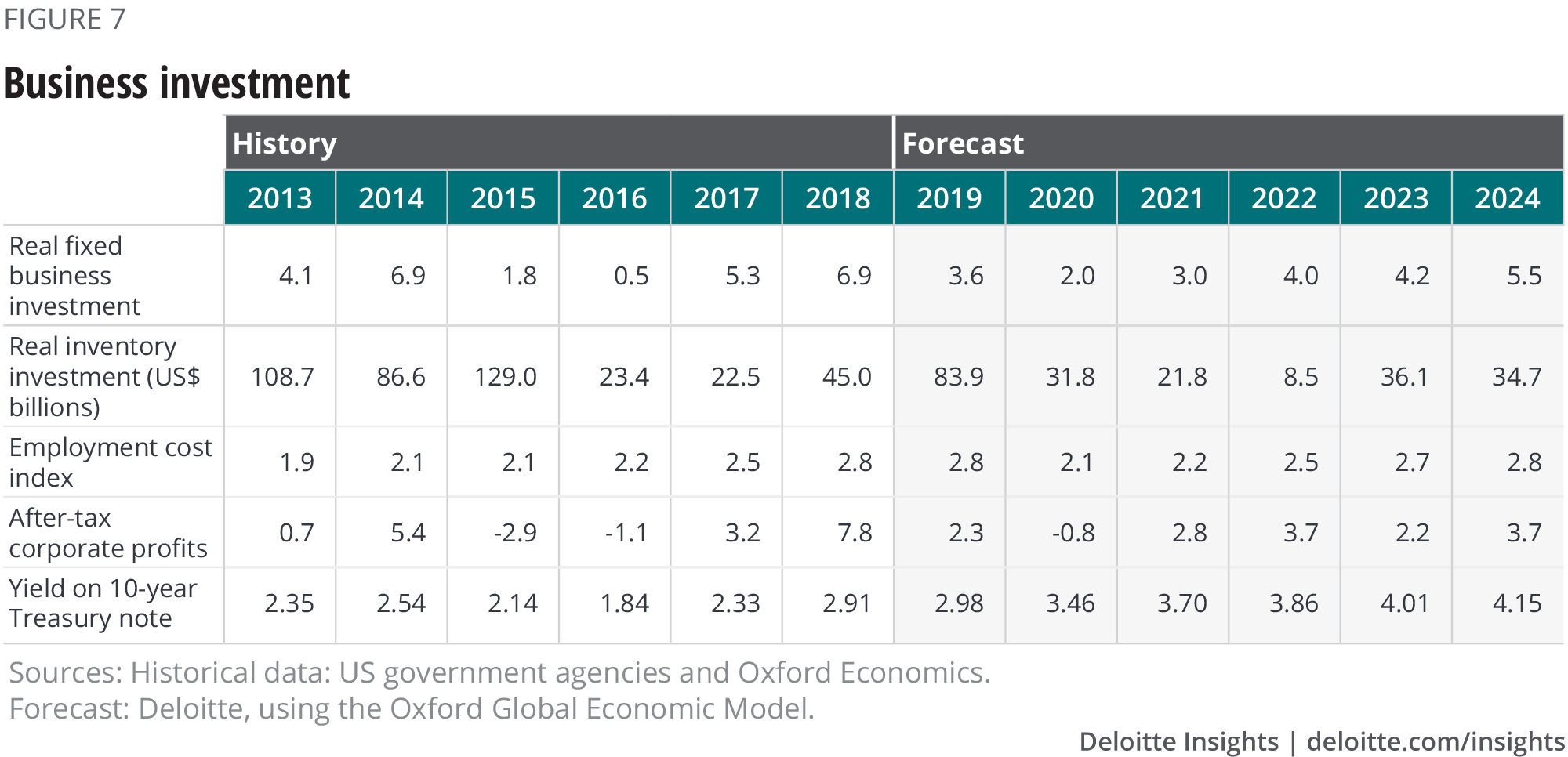
Foreign trade
Over the past few decades, business—especially manufacturing—has taken advantage of generally open borders and cheap transportation to cut costs and improve global efficiency. The result is a complex matrix of production that makes the traditional measures of imports and exports somewhat misleading. For example, in 2017, 37.0 percent of Mexico’s exports to the United States consisted of intermediate inputs purchased from ... the United States.11
Recent events appear to be placing this global manufacturing system at risk. The United Kingdom’s increasingly tenuous post-Brexit position in the European manufacturing ecosystem,12 along with ongoing negotiations to replace the North American Free Trade Agreement, may slow the growth of this system or even cause it to unwind.
But the biggest challenge now facing the global trading system is the imposition of tariffs and retaliatory tariffs. The process began with US tariffs on solar panels and washing machines and now encompasses a wide variety of American imports from China and other countries. And those countries have responded, leaving an increasing amount of US exports subject to foreign retaliatory tariffs. US-China trade talks may have stalled. Both sides claim they are talking, but in May the United States imposed additional tariffs on Chinese products, China responded with its own tariffs, and escalation threatens.13
Whether this qualifies as a “trade war” is a semantic question. The real issue is the uncertainty about the tariffs and the US government’s goals in imposing these taxes. White House trade adviser Peter Navarro argues that the tariffs are necessary to reduce the US trade deficit and to help the United States strengthen domestic industries such as steel production for strategic reasons.14 This suggests that tariffs in “strategic” industries could be permanent. But Commerce Secretary Wilbur Ross has stated that the goal is to force US trading partners to lower their own barriers to American exports.15 That suggests that the administration intends the tariffs to be a temporary measure to be traded for better access to foreign markets.
The apparent lack of clarity in the administration’s stated objectives for tariffs adds to the overall uncertainty about global trade policy. In the short run, uncertainty about border-crossing costs may reduce investment spending. Businesses may be reluctant to invest when facing the possibility of a sudden shift in costs. Deloitte’s slow-growth scenario assumes that the impact is large enough to affect overall business investment.
The challenge that companies face is that a significant change in border-crossing costs—as would occur if the United States withdrew from NAFTA without adopting its replacement, the United States-Mexico-Canada Agreement (USMCA), or made tariffs on Chinese goods permanent—could potentially reduce the value of capital investment put in place to take advantage of global goods flows. Essentially, the global capital stock could depreciate more quickly than our normal measures would suggest. In practical terms, some US plants and equipment could go idle without the ability to access foreign intermediate products at previously planned prices.
With this loss of productive capacity would come the need to replace it with plants and equipment that would be profitable at the higher border cost. We might expect gross investment to increase once the outline of a new global trading system becomes apparent.
In the longer term, a more protectionist environment is likely to raise costs. That’s a simple conclusion to be drawn from the fact that globalization was largely driven by businesses trying to cut costs. How those extra costs are distributed depends a great deal on economic policy—for example, central banks can attempt to fight the impact of lower globalization on prices (with a resulting period of high unemployment) or to accommodate it (allowing inflation to pick up).
Whatever happens, the tariffs are unlikely to have a direct impact on the US current account (except perhaps in the very short run). The current account is determined by global financial flows, not trade costs.16 Any potential reduction in the current account deficit is likely to be largely offset by a reduction in American competitiveness through higher costs in the United States, lower costs abroad, and a higher dollar. All four scenarios of our forecast assume that the direct impact of trade policy on the current account deficit is relatively small.
Adding to the problems in the trade sector, growth in Europe and China has clearly slowed. These are two of the three regions that drive the global economy (the third is the United States). Slow growth abroad is very likely to translate into slower growth in US exports and perhaps a higher dollar, further slowing export growth. That’s an important contributor to downside risk for the American economy.
Brexit is an immediate issue in the short run, although it does not affect the medium- or long-term US outlook that much. A hard Brexit is unlikely to significantly affect US sales abroad directly. But it could help soften overall European economic growth even further—providing yet another headwind for American exporters.
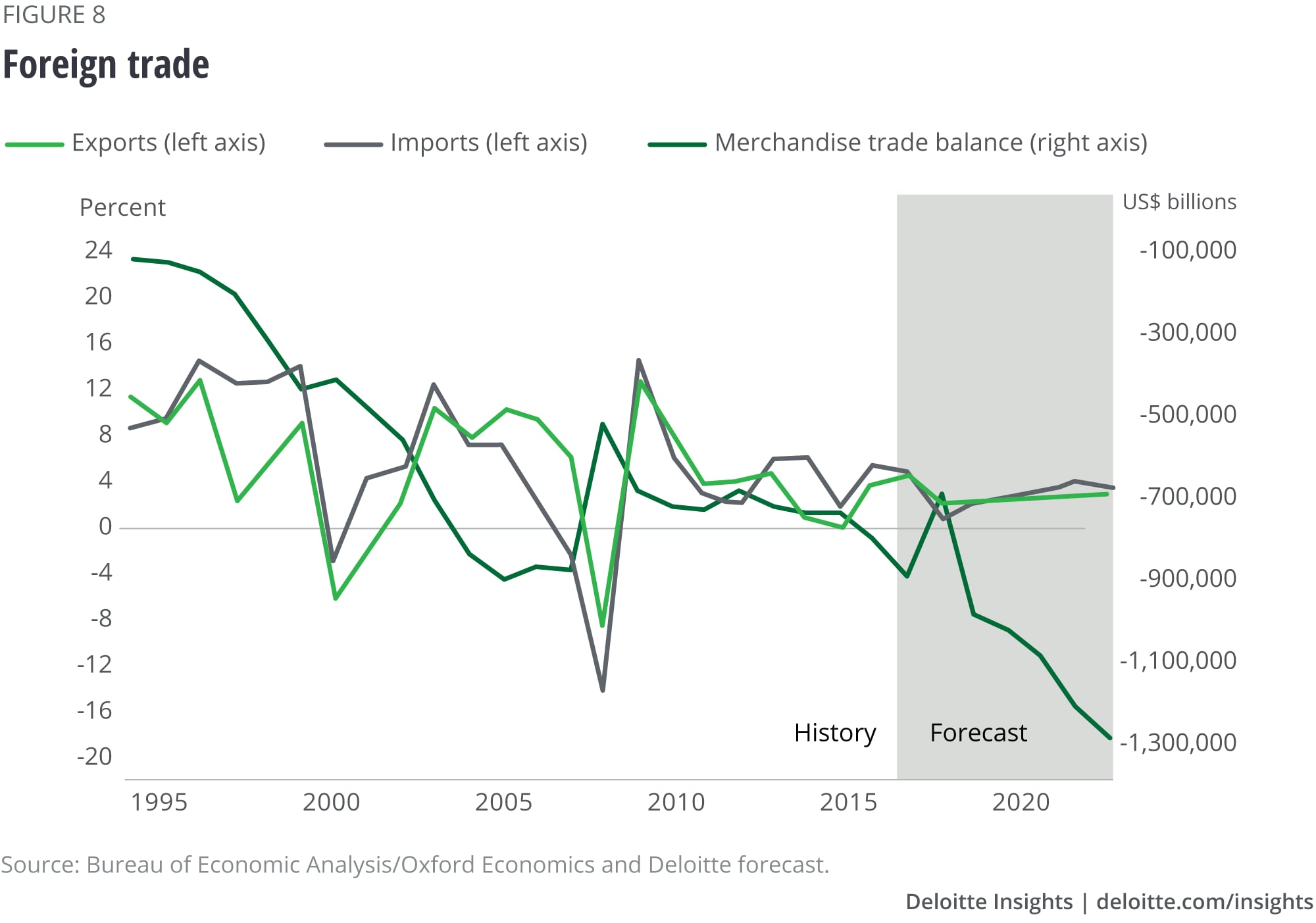
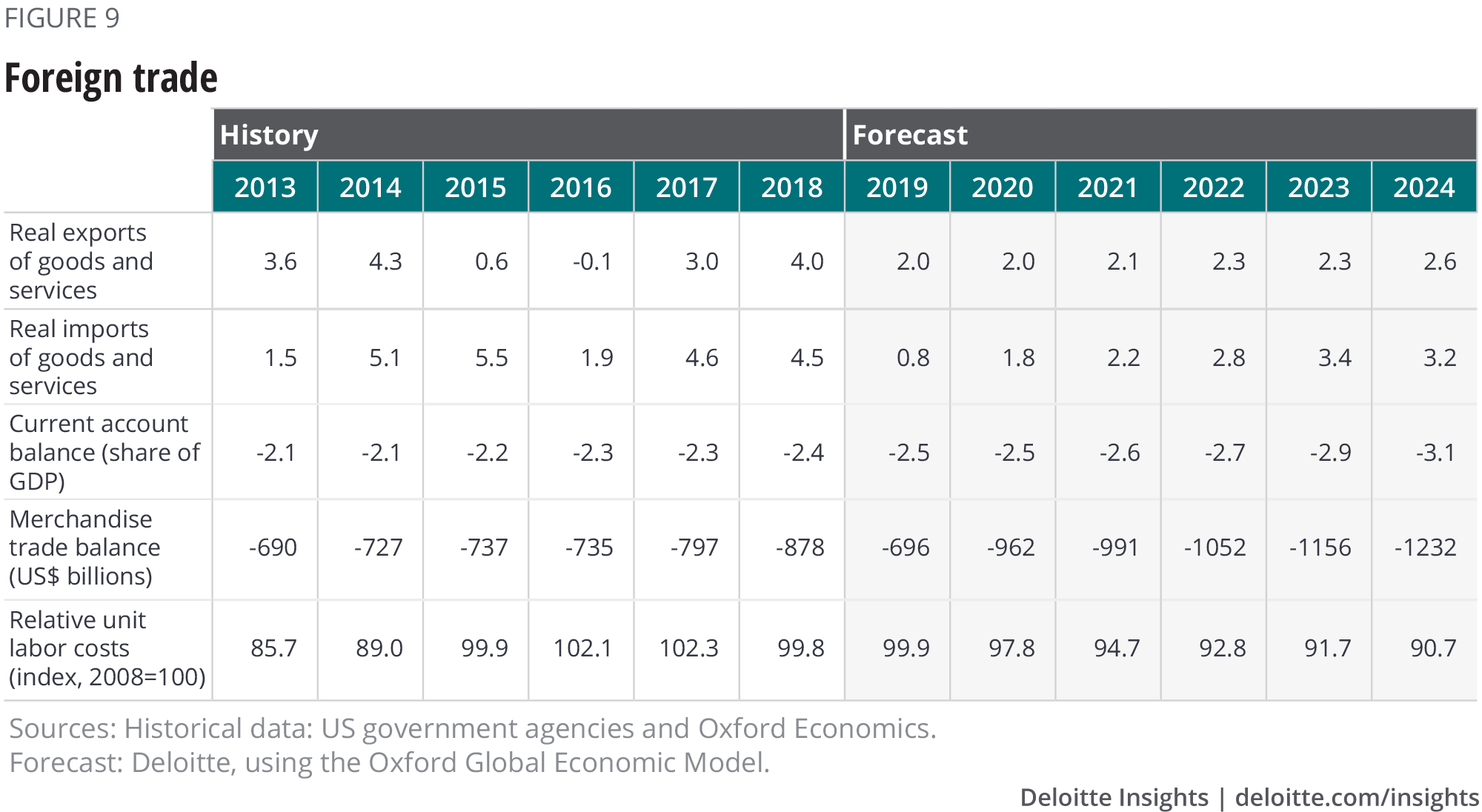
Government
Government spending provides an unusual source of volatility in the Deloitte forecast. The tax bill passed in late 2017 and the budget bill passed in early 2018 together created a large stimulus—over 2.0 percent of GDP, by Deloitte calculations—in 2019. As the stimulus ends in late 2019, that government spending will likely start falling. This drag on the economy is large enough to slow growth substantially. The Deloitte baseline forecast projects GDP growth to be only 1.2 percent in 2020, quite a bit below potential.
The tax bill’s long-run impact on the economy’s capacity remains a matter of debate, with estimates ranging from no real change after a decade (Tax Policy Center) to 2.8 percent, or almost 0.3 percentage points annually (Tax Foundation).17 In this forecast’s five-year horizon, the supply-side impact is likely too small to be noticeable. The demand-side impact is a rise in spending in 2018 and early 2019 (which has mostly taken place) and a decline in spending in late 2019 and ’20 as the budget caps go back in place and outlays fall. And that impact overwhelms the supply-side impact during the five-year forecast horizon.
The midterm elections returned a Democratic House and Republican Senate, likely taking major economic policy changes off the table until after 2020.18 The split Congress may complicate budget decision-making over the next couple of years—although the budget has been a source of uncertainty even when Congress has been under single-party control. The past year’s shutdown demonstrates the potential of the current political environment to intensify policy uncertainty. And more deadlines loom.
The debt ceiling suspension expired on March 2. As it has done in the past, the Treasury Department is employing “extraordinary measures” to keep funds flowing.19 At some point, however, Congress will have to act—probably in late summer or early fall. At that point, another deadline will loom: FY 2020 (at the beginning of October) and the need to pass appropriations bills by then. These continued deadlines have created permanent uncertainty about US government finances. Congress may agree to a longer-term budget deal to push further debate past the next presidential election (the best case), or the deliberations may result in further budget policy uncertainty. The difficulty in passing a disaster relief bill—normally a slam dunk for members of Congress wanting to show both their compassion and ability to secure federal funds—suggests that negotiations may be difficult.
There may be room for some positive surprises. Democratic leaders in Congress and President Trump have had some showy meetings about infrastructure. However, obtaining agreement on this may be difficult because the two sides have very different views of how, specifically, to proceed, with no clear funding source. (And Republican leaders in Congress have been unenthusiastic about the idea).20 Our baseline assumes no infrastructure plan, while the productivity-bonanza scenario assumes some additional government spending as well as additional productivity from these investments in the medium and long runs.
After years of belt-tightening, many state and local governments are no longer actively cutting spending. However, many state budgets remain constrained by questions around the effects of new federal tax policy21 and the need to meet large unfunded pension obligations,22 so state and local spending growth will likely remain low over this forecast’s five-year horizon.
Pressure is building for increased spending in education, as evidenced by the ongoing public teacher protests in several states.23 With education costs accounting for about a third of all state and local spending, a significant upturn in this category could create some additional stimulus—or could require an increase in state and local taxes.
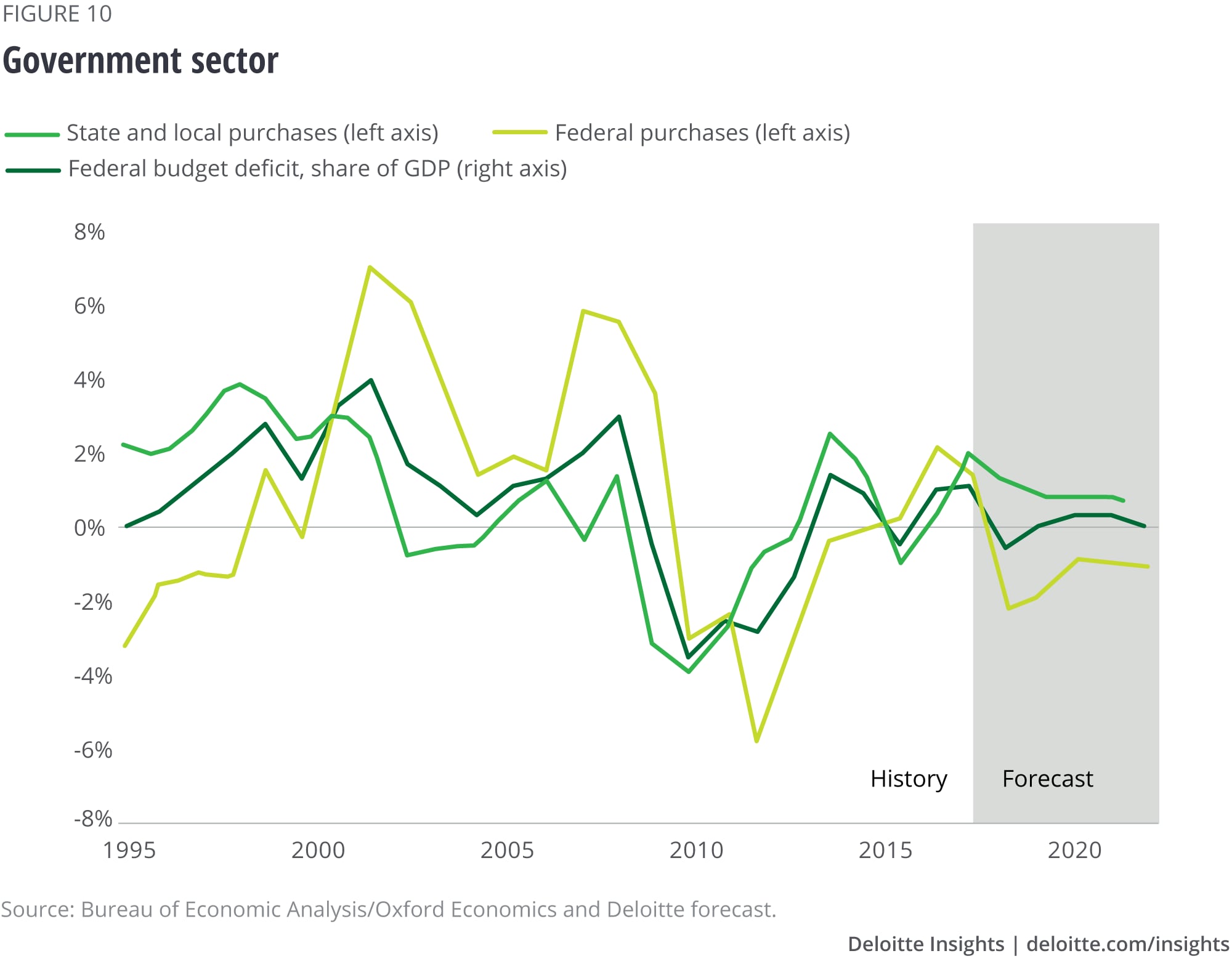
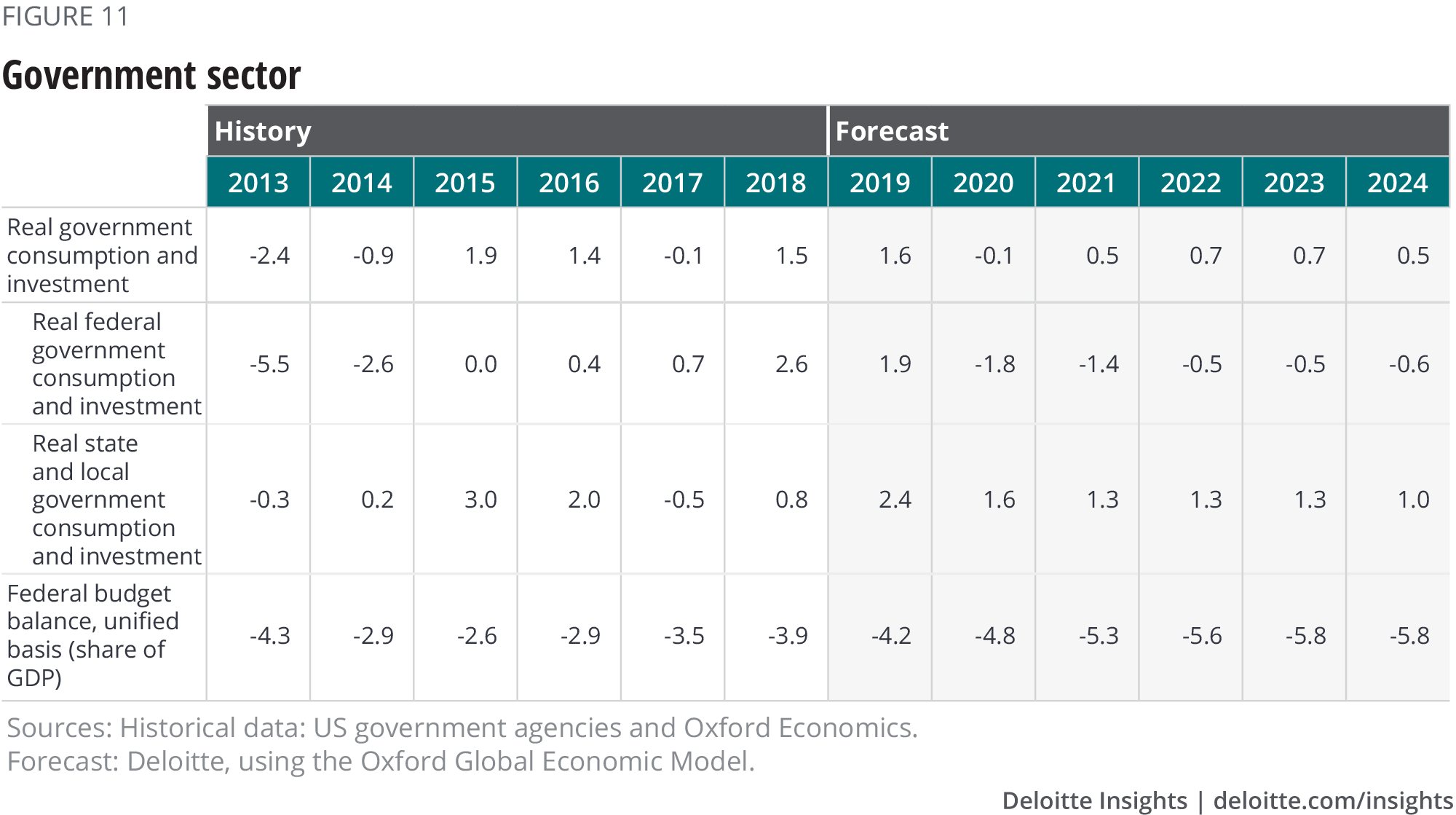
Labor markets
If the American economy is to effectively produce more goods and services, it will need more workers. Many potential employees remain out of the labor force, having left in 2009, when the labor market was challenging. But they are returning. The labor force participation rate for 24–54-year-old workers started rising in the middle of 2015. As of April, this figure was over 82 percent. But this is still below the peak of over 84.0 percent reached in the late 1990s, suggesting that there may be a considerable number of workers who can be enticed back into the labor market as conditions improve. Our baseline forecast reflects that possibility.
Meanwhile, the labor force participation rate for over-65s is rising. At almost 20 percent, it’s much higher than the historical average—and it is certainly possible that, with better labor market conditions, employers can entice even more over-65s back into the labor force.
But a great many people are still on the sidelines and have been out of steady employment for years—long enough that their basic work skills may be eroding. Are those people still employable? So far, the answer has been “yes,” as job growth continues to be strong without pushing up wages. Deloitte’s forecast team remains optimistic that improvements in the labor market will prove increasingly attractive to potential workers, and labor force participation is likely to continue to improve accordingly. However, we are now close enough to full employment that average monthly job growth is likely to drop from the current 200,000 per month to about 100,000 per month in the next two years, even if the economy remains healthy.
In the longer run, demographics are slowing the growth of the population in prime labor force age. As boomers age, lagging demographic growth will help slow the economy’s potential growth. That’s why we foresee trend GDP growth below 2.0 percent by 2021: Even with an optimistic view about productivity, we expect that slow labor force growth will eventually be felt in lower economic growth.
Immigration reform might have a marginal impact on the labor force. According to the Pew Research Center, undocumented immigrants make up about 4.8 percent of the total American labor force.24 Immigration reform that restricts immigration and/or increases the removal of undocumented workers might create labor shortages in certain industries, such as agriculture, in which a quarter of workers are unauthorized,25 and construction, in which an estimated 15 percent of workers are unauthorized.26 But it would likely have little significant impact at the aggregate level.
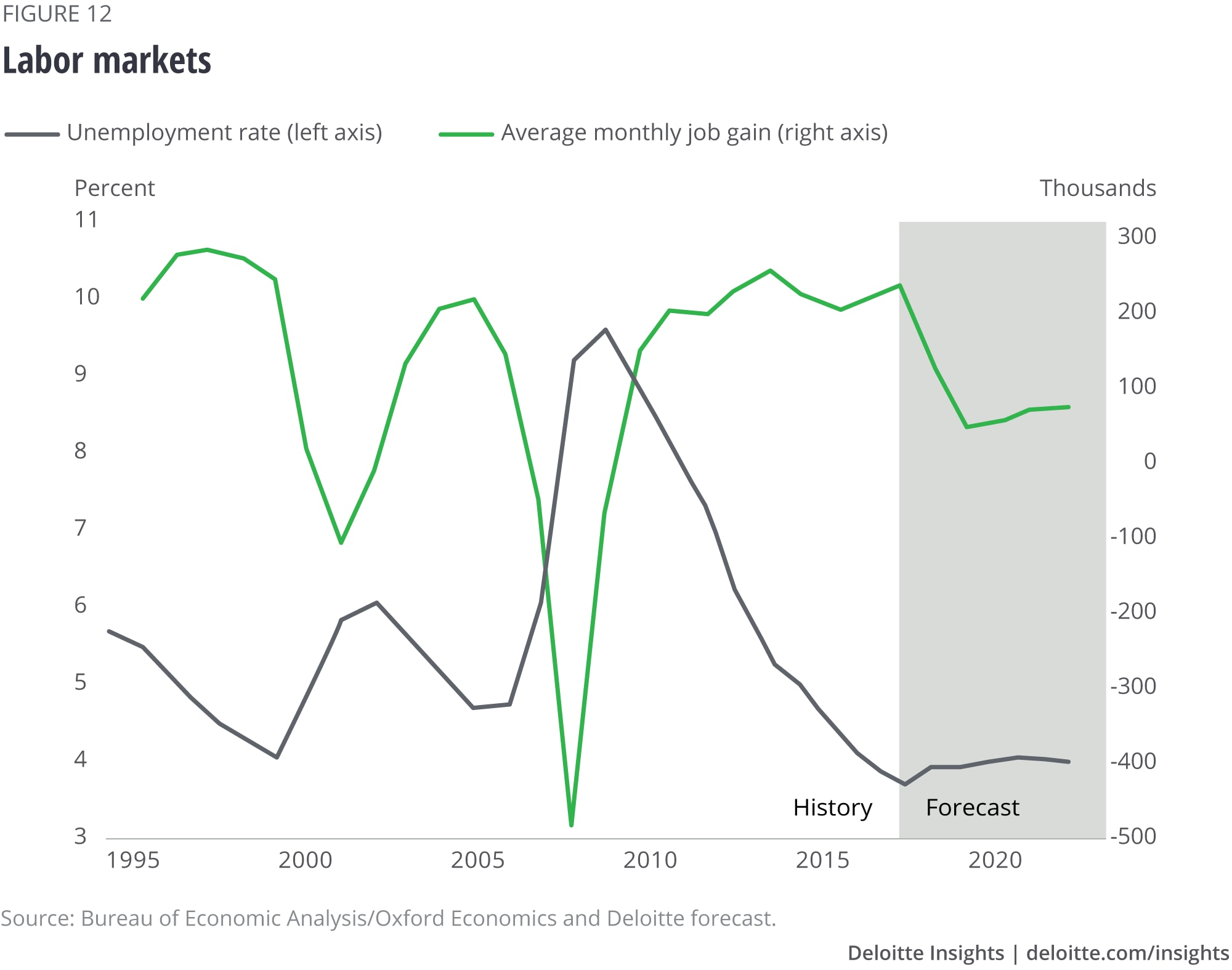

Financial markets
Interest rates are among the most difficult economic variables to forecast because movements depend on news—and if we knew it ahead of time, it wouldn’t be news. The Deloitte interest rate forecast is designed to show a path for rates consistent with the forecast for the real economy. But the potential risk for different interest rate movements is higher here than in other parts of our forecast.
Short-term interest rates now seem to have plateaued, with market commentary focused on the Fed cutting rates. This is probably wishful thinking, as long as the labor market continues to deliver good news. Many Fed officials seem to have concluded that short-term interest rates are at a “neutral” level—the rate that is consistent with full employment and stable inflation. FOMC members’ central estimate for the longer-run value of the Fed funds rate is now just 2.8 percent.27
The spread between long- and short-term rates has been remarkably small lately. It may remain that way for a while, but eventually, the forecast expects the spread to widen back to about 1.0 to 1.5 percentage points. That’s consistent with historical experience but does suggest that long-term rates are likely to rise to 3.5 percent or even 4.0 percent once the economy passes the period of weakness we expect in 2020. That’s not necessarily a bad thing. It’s part of the “return to normal” that the US economy is experiencing.
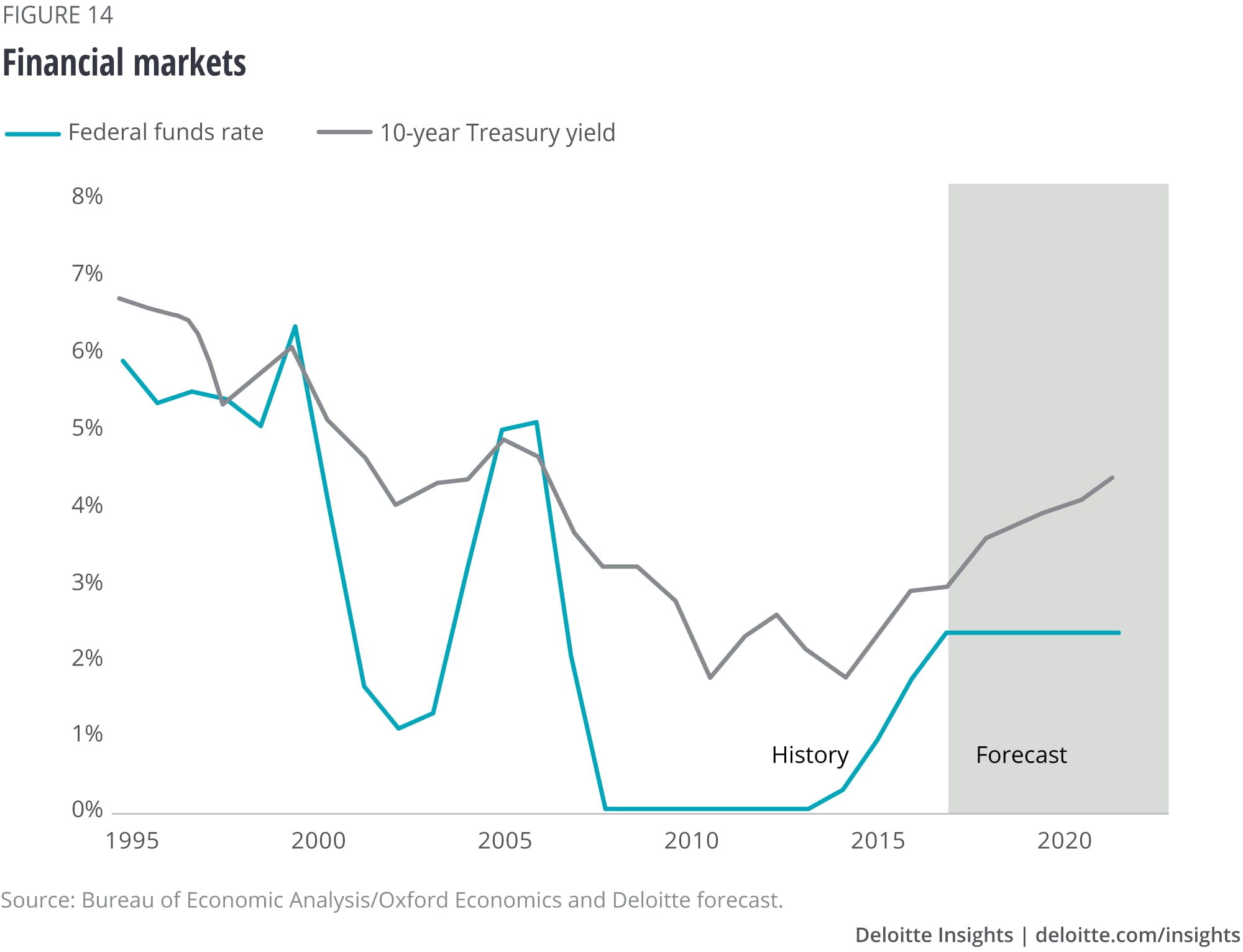
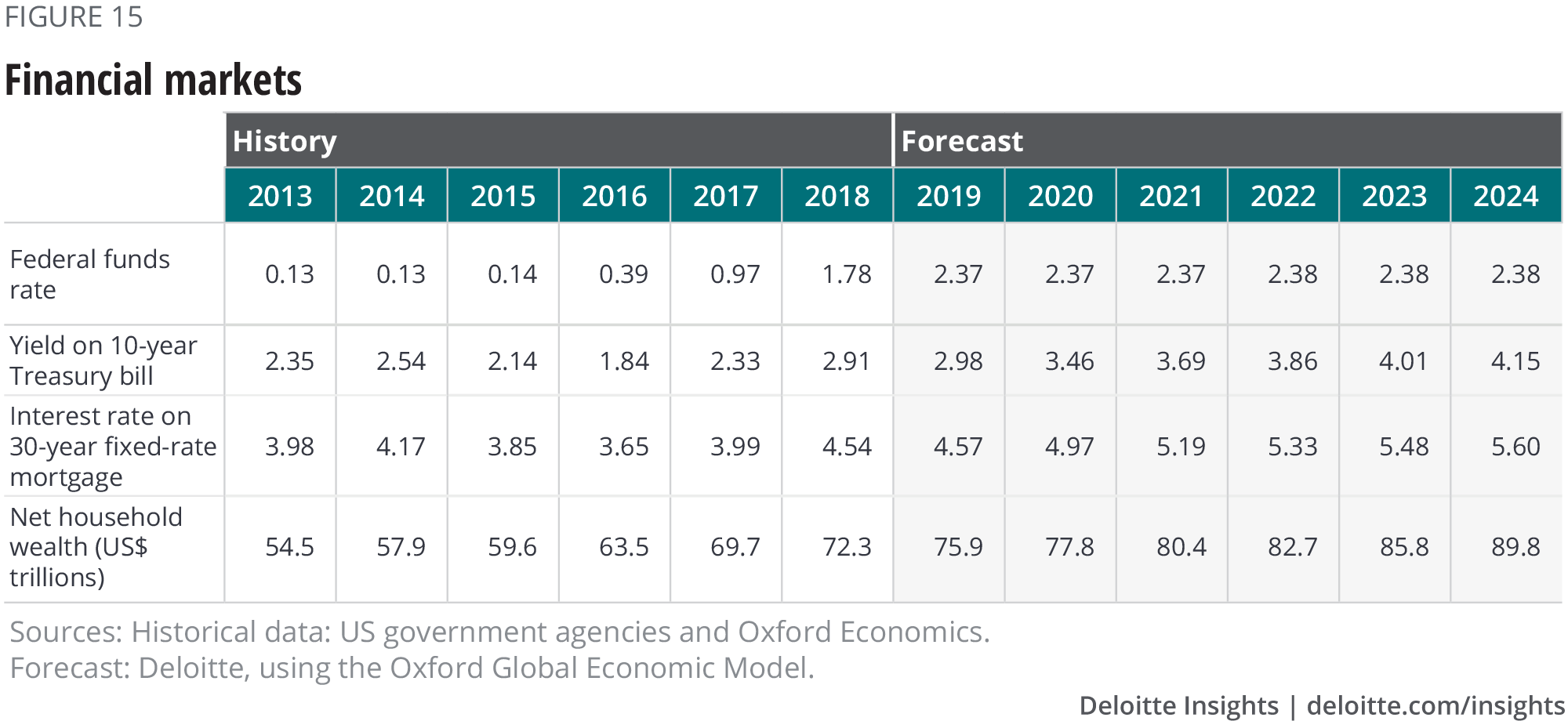
Prices
It’s been a long time since inflation has posed a problem for American policymakers. Could price instability break out as the economy reaches full employment? Many economists are increasingly wondering about this, as it becomes evident that something is amiss in the standard inflation models. These models posit that, since labor accounts for about 70 percent of business costs, tight labor markets driving higher wages would be the main cause of accelerating inflation. US labor markets appear to be tightening, but wages have failed to rise accordingly.28 Real wages for nonsupervisory employees have started to rise, but with productivity also accelerating, real unit labor costs have slowed in the past year.29 As long as businesses don’t face increasing costs, it’s hard to see what could drive a sustained rise in goods and services prices.
But it’s also quite possible that the economy simply hasn’t hit full employment. Despite unemployment dipping below 4.0 percent, the labor force participation rate for prime-age workers remains about two points below the rate before the financial crisis. Two percent of the prime working-age population suggests that about 4 million more people could be enticed into the labor force under the right conditions. Whether those people are available is unclear, and many economists are debating the issue fiercely.30 The combination of low labor-cost growth and continued high employment growth suggests that people are likely being enticed back into the labor market.
At some point, however, the combination of the tax cut and spending increase could create some shortages in both labor and product markets and, as a result, some inflation. And tariffs are something of a wild card. So far, although most of the tariffs have been on intermediate products, there is evidence that the additional cost was simply passed through to final consumers.31 The most recent tariff increase included more consumer goods and may be felt directly in the CPI. Interpreting inflation data under those circumstances could be tricky. And if that rise sparks wage hikes to maintain real wages—a possibility at current unemployment rates—inflation could indeed tick up.
A return to 1970s-style inflation is about as likely as polyester leisure suits coming back into style. But it would not be surprising in these circumstances to see the core CPI rise to above 2.5 percent. Our forecast expects timely Fed action to prevent inflation from rising too much, but the price (of course) is higher interest rates.
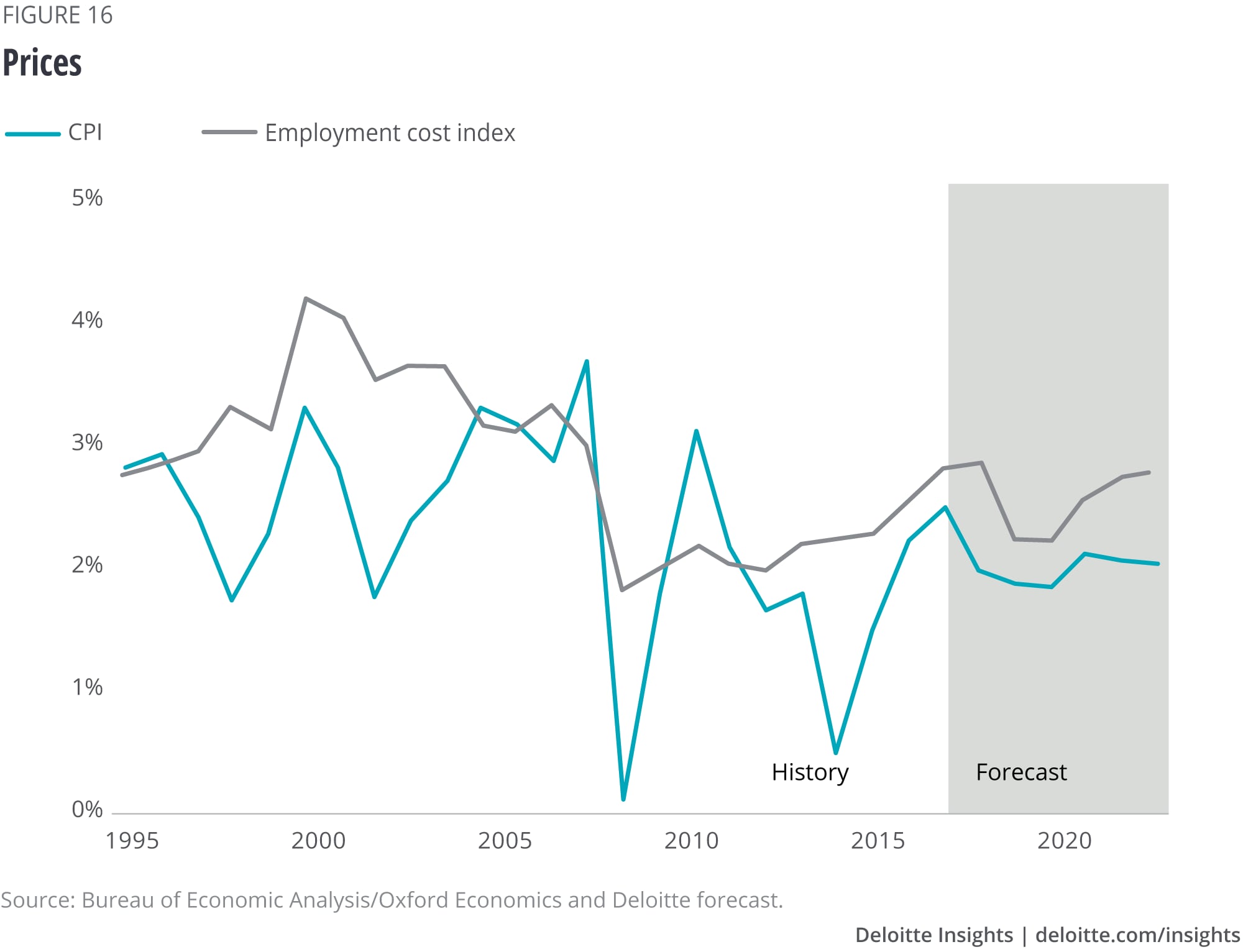
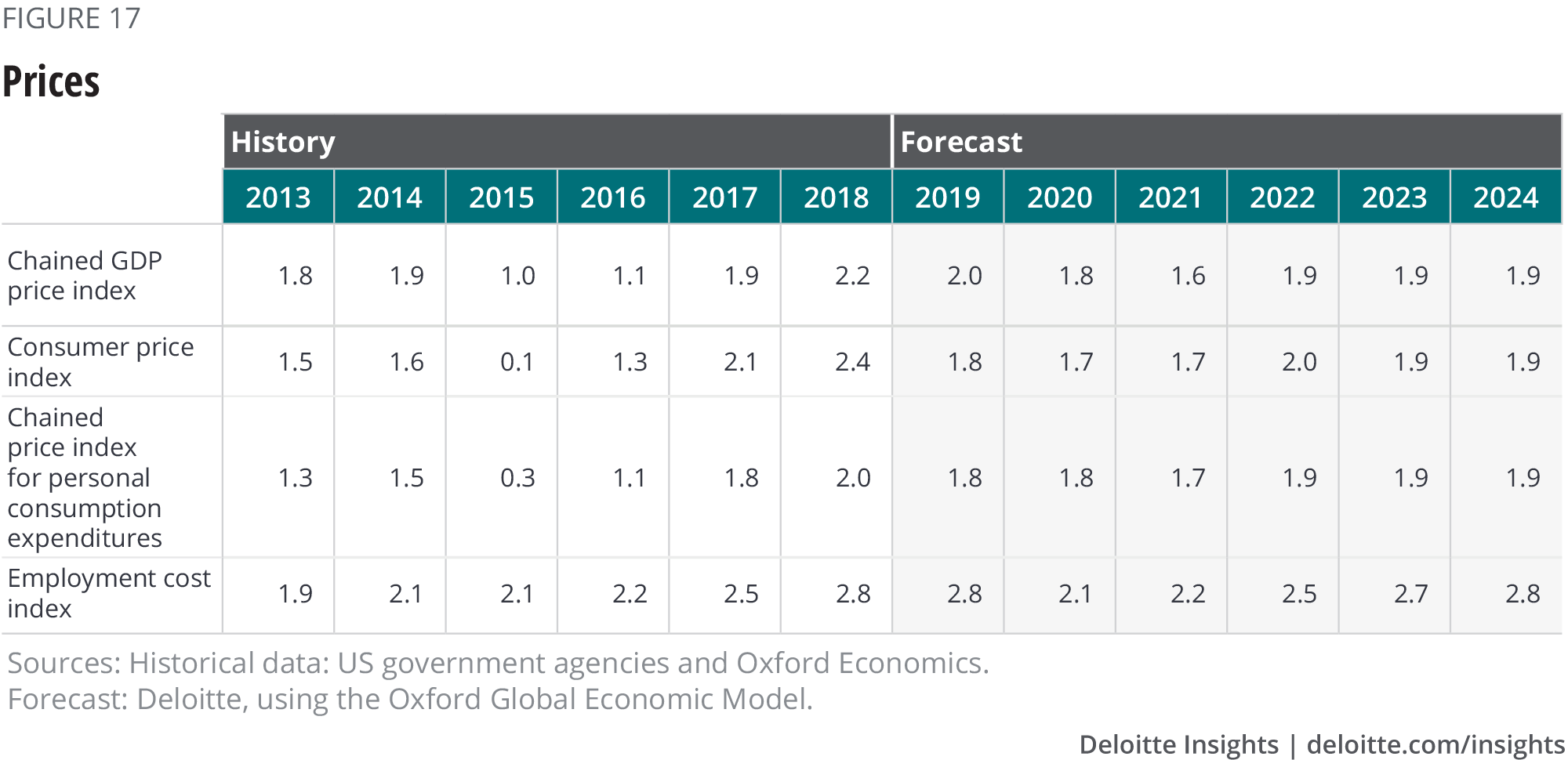
Appendix

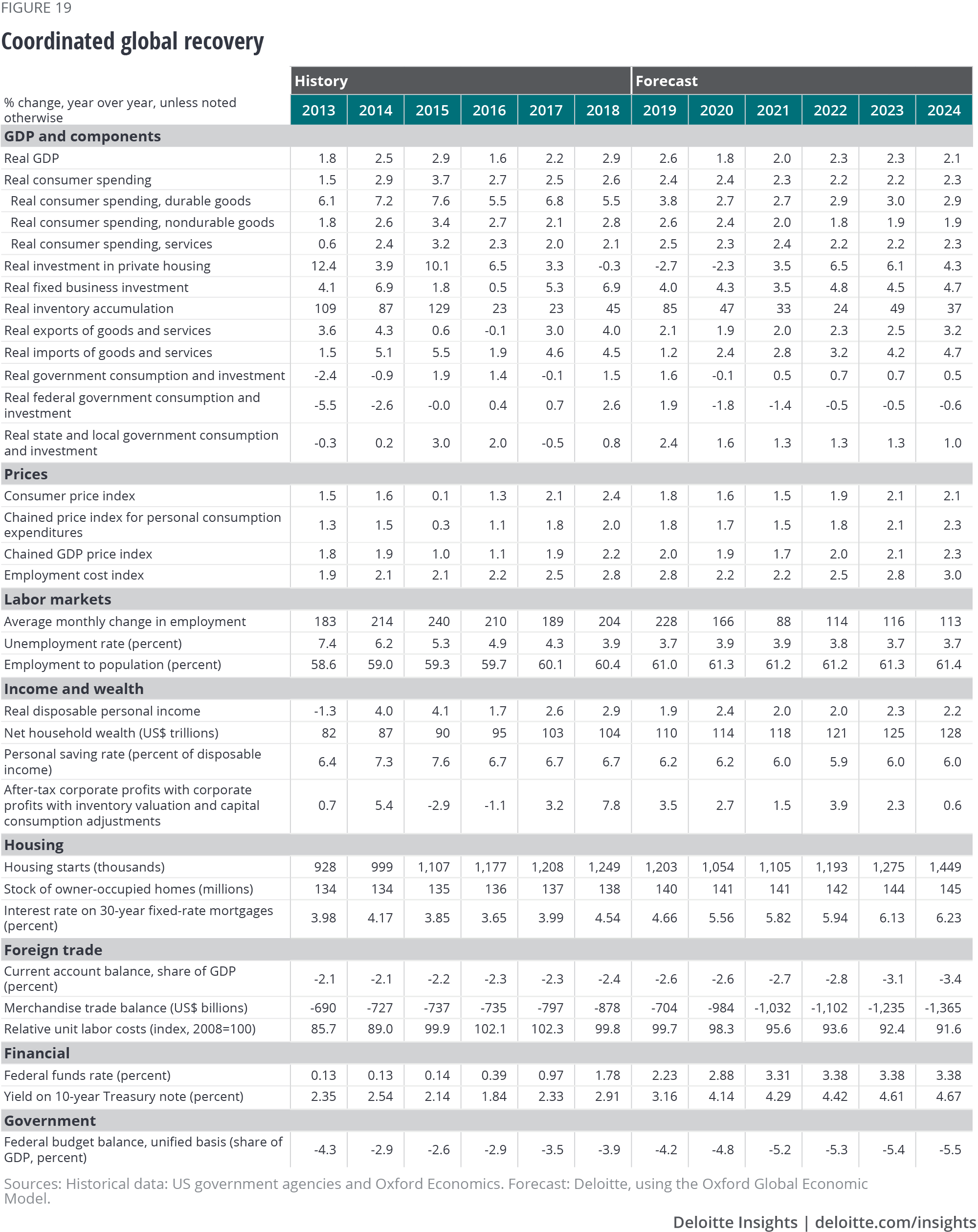
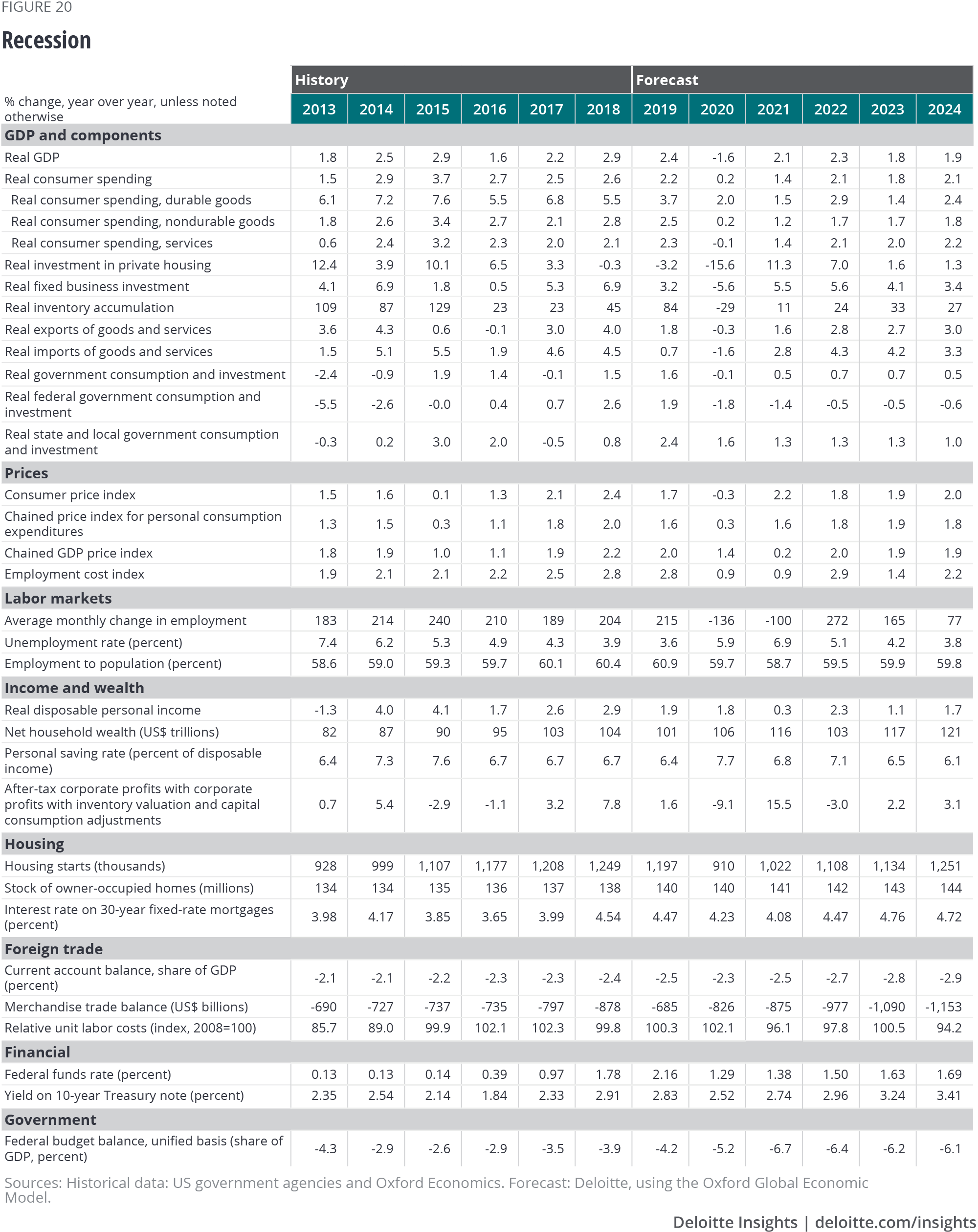
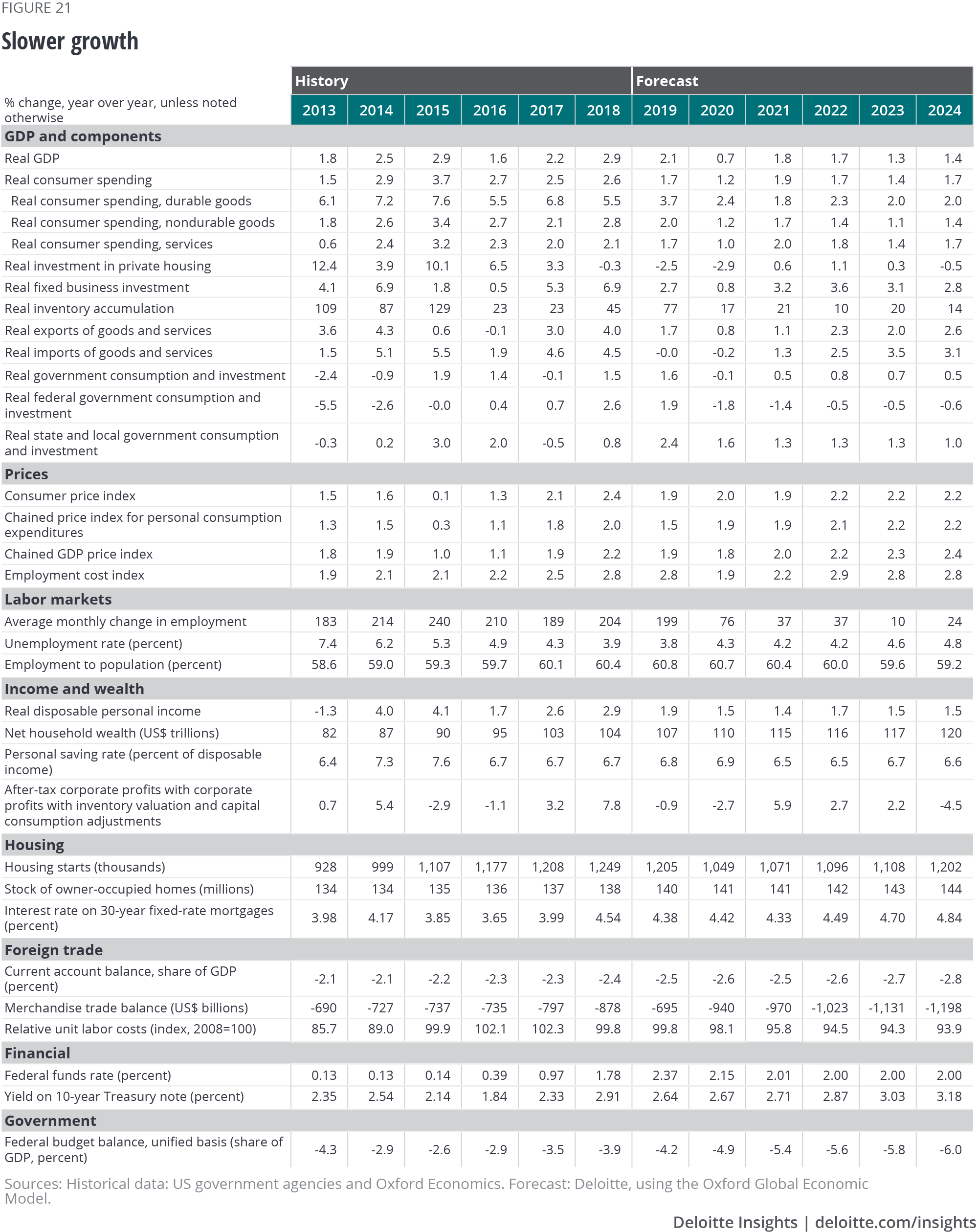
Explore the economics collection
-
A forecast of housing construction in the United States Article5 years ago
-
Eurozone economic outlook, September 2024 Article2 months ago
-
Rising corporate debt: Should we worry? Article5 years ago
-
China economic outlook, February 2023 Article1 year ago
-
Canada Economic Outlook Article4 years ago
-
How the financial crisis reshaped the world’s workforce Article5 years ago













